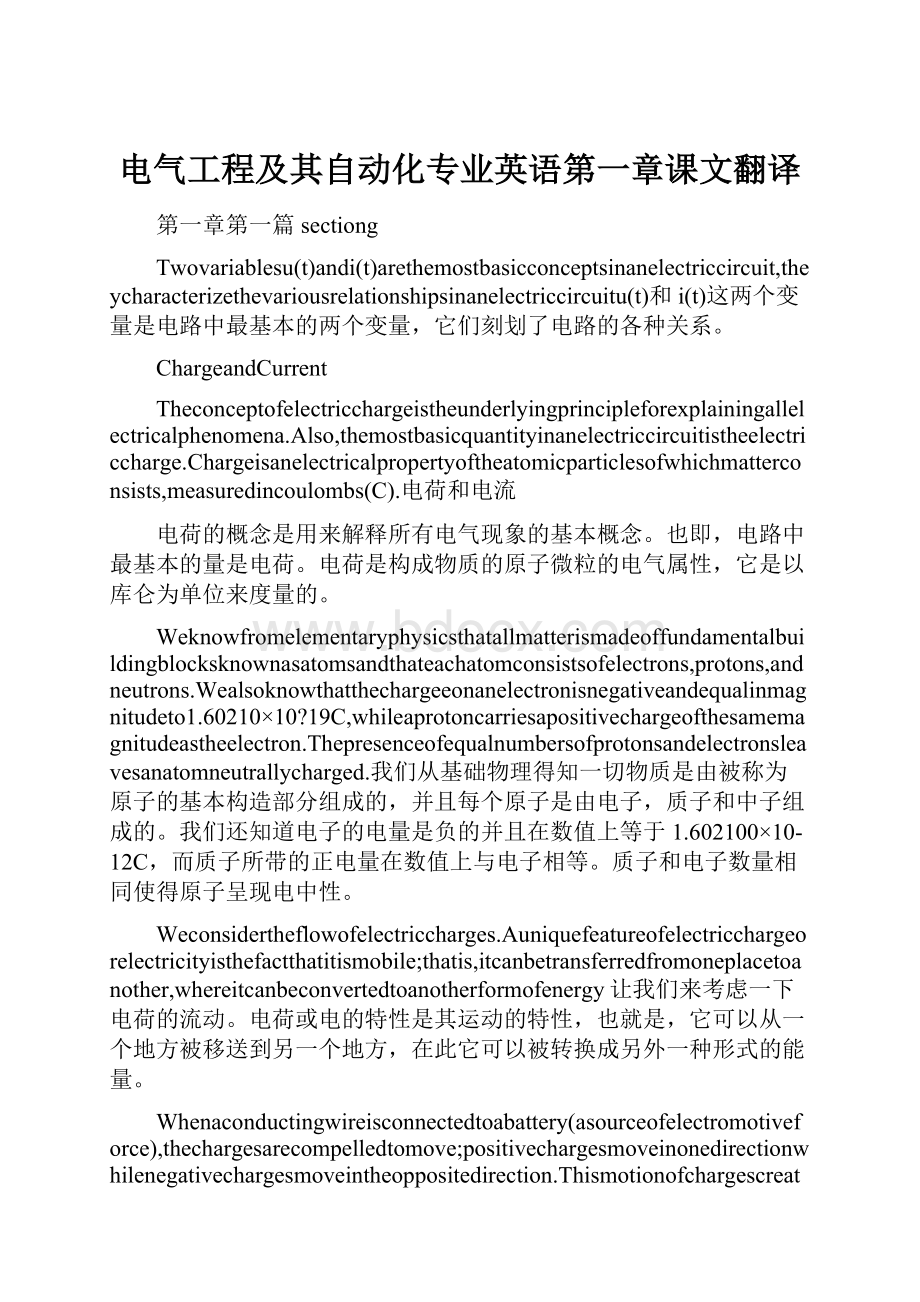 电气工程及其自动化专业英语第一章课文翻译.docx
电气工程及其自动化专业英语第一章课文翻译.docx
- 文档编号:29259385
- 上传时间:2023-07-21
- 格式:DOCX
- 页数:33
- 大小:52.30KB
电气工程及其自动化专业英语第一章课文翻译.docx
《电气工程及其自动化专业英语第一章课文翻译.docx》由会员分享,可在线阅读,更多相关《电气工程及其自动化专业英语第一章课文翻译.docx(33页珍藏版)》请在冰豆网上搜索。

电气工程及其自动化专业英语第一章课文翻译
第一章第一篇sectiong
Twovariablesu(t)andi(t)arethemostbasicconceptsinanelectriccircuit,theycharacterizethevariousrelationshipsinanelectriccircuitu(t)和i(t)这两个变量是电路中最基本的两个变量,它们刻划了电路的各种关系。
ChargeandCurrent
Theconceptofelectricchargeistheunderlyingprincipleforexplainingallelectricalphenomena.Also,themostbasicquantityinanelectriccircuitistheelectriccharge.Chargeisanelectricalpropertyoftheatomicparticlesofwhichmatterconsists,measuredincoulombs(C).电荷和电流
电荷的概念是用来解释所有电气现象的基本概念。
也即,电路中最基本的量是电荷。
电荷是构成物质的原子微粒的电气属性,它是以库仑为单位来度量的。
Weknowfromelementaryphysicsthatallmatterismadeoffundamentalbuildingblocksknownasatomsandthateachatomconsistsofelectrons,protons,andneutrons.Wealsoknowthatthechargeeonanelectronisnegativeandequalinmagnitudeto1.60210×10?
19C,whileaprotoncarriesapositivechargeofthesamemagnitudeastheelectron.Thepresenceofequalnumbersofprotonsandelectronsleavesanatomneutrallycharged.我们从基础物理得知一切物质是由被称为原子的基本构造部分组成的,并且每个原子是由电子,质子和中子组成的。
我们还知道电子的电量是负的并且在数值上等于1.602100×10-12C,而质子所带的正电量在数值上与电子相等。
质子和电子数量相同使得原子呈现电中性。
Weconsidertheflowofelectriccharges.Auniquefeatureofelectricchargeorelectricityisthefactthatitismobile;thatis,itcanbetransferredfromoneplacetoanother,whereitcanbeconvertedtoanotherformofenergy让我们来考虑一下电荷的流动。
电荷或电的特性是其运动的特性,也就是,它可以从一个地方被移送到另一个地方,在此它可以被转换成另外一种形式的能量。
Whenaconductingwireisconnectedtoabattery(asourceofelectromotiveforce),thechargesarecompelledtomove;positivechargesmoveinonedirectionwhilenegativechargesmoveintheoppositedirection.Thismotionofchargescreateselectriccurrent.Itisconventionaltotakethecurrentflowasthemovementofpositivecharges,thatis,oppositetotheflowofnegativecharges,asFig.l-1illustrates.ThisconventionwasintroducedbyBenjaminFranklin(l706~l790),theAmericanscientistandinventor.Althoughwenowknowthatcurrentinmetallicconductorsisduetonegativelychargedelectrons,wewillfollowtheuniversallyacceptedconventionthatcurrentisthenetflowofpositivecharges.Thus,Electriccurrentisthetimerateofcharge,measuredinamperes(A).Mathematically,therelationshipamongcurrenti,chargeq,andtimetis
当我们把一根导线连接到某一电池上时(一种电动势源),电荷被外力驱使移动;正电荷朝一个方向移动而负电荷朝相反的方向移动。
这种电荷的移动产生了电流。
我们可以很方便地把电流看作是正电荷的移动,也即,与负电荷的流动方向相反,如图1-1所示。
这一惯例是由美国科学家和发明家本杰明-富兰克林引入的。
虽然我们现在知道金属导体中的电流是由负电荷引起的,但我们将遵循通用的惯例,即把电流看作是正电荷的单纯的流动。
于是电流就是电荷的时率,它是以安培为单位来度量的。
从数学上来说,电流i、电荷q以及时间t之间的关系是:
Thechargetransferredbetweentimet0andtisobtainedbyintegratingbothsidesofEq.(1-1).Weobtain从时间t0到时间t所移送的电荷可由方程(1-1)两边积分求得。
我们算得:
ThewaywedefinecurrentasiinEq.(1-l)suggeststhatcurrentneednotbeaconstant-valuedfunction,chargecanvarywithtimeinseveralwaysthatmayberepresentedbydifferentkindsofmathematicalfunctions我们通过方程(1-1)定义电流的方式表明电流不必是一个恒值函数,电荷可以不同的方式随时间而变化,这些不同的方式可用各种数学函数表达出来。
电压,能量和功率
Tomovetheelectroninaconductorinaparticulardirectionrequiressomeworkorenergytransfer.Thisworkisperformedbyanexternalelectromotiveforce(emf),typicallyrepresentedbythebatteryinFig.l-1.Thisemfisalsoknownasvoltageorpotentialdifference.Thevoltageuabbetweentwopointsaandbinanelectriccircuitistheenergy(orwork)neededtomoveaunitchargefromatob;mathematically在导体中朝一个特定的方向移动电荷需要一些功或者能量的传递,这个功是由外部的电动势来完成的。
图1-1所示的电池就是一个典型的例子。
这种电动势也被称为电压或电位差。
电路中a、b两点间的电压等于从a到b移动单位电荷所需的能量(或所需做的功)。
数学表达式为:
wherewisenergyinjoules(J)andqischargeincoulombs(C).Thevoltageuabismeasuredinvolts(V),namedinhonoroftheItalianphysicistAlessandroAntonioVolta(l745~l827),whoinventedthefirstvoltaicbattery.Thus,Voltage(orpotentialdifference)istheenergyrequiredtomoveaunitchargethroughanelement,measuredinvolts(V).式中w是单位为焦耳的能量而q是单位为库仑的电荷。
电压Uab是以伏特为单位来度量的,它是为了纪念意大利物理学家AlessandroAntonioVolta而命名的,这位意大利物理学家发明了首个伏达电池。
于是电压(或电压差)等于将单位电荷在元件中移动所需的能量,它是以伏特为单位来度量的。
Fig.l-2showsthevoltageacrossanelement(representedbyarectangularblock)connectedtopointsaandb.Theplus(+)andminus(-)signsareusedtodefinereferencedirectionorvoltagepolarity.Theuabcanbeinterpretedintwoways:
①pointaisatapotentialofuabvoltshigherthanpointb;②thepotentialatpointawithrespecttopointbisuab.Itfollowslogicallythatingeneral图1-2显示了某个元件(用一个矩形框来表示)两端a、b之间的电压。
正号(+)和负号(-)被用来指明参考方向或电压的极性,Uab可以通过以下两种方法来解释。
1)在Uab伏特的电位中a点电位高于b点,2)a点电位相对于b点而言是Uab,通常在逻辑上遵循
Althoughcurrentandvoltagearethetwobasicvariablesinanelectriccircuit,theyarenotsufficientbythemselves.Forpracticalpurposes,weneedtoknowpowerandenergy.Torelatepowerandenergytovoltageandcurrent,werecallfromphysicsthatpoweristhetimerateofexpendingorabsorbingenergy,measuredinwatts(W).Wewritethisrelationshipas
虽然电流和电压是电路的两个基本变量,但仅有它们两个是不够的。
从实际应用来说,我们需要知道功率和能量。
为了把功率和能量同电压、电流联系起来,我们重温物理学中关于功率是消耗或吸收的能量的时率,它是以瓦特为单位来度量的。
我们把这个关系式写成:
Wherepispowerinwatts(W),wisenergyinjoules(J),andtistimeinseconds(s).FromEq.(1-1),Eq.(1-3),andEq.(1-5),itfollowsthat式中p是以瓦特为单位的功率,w是以焦耳为单位的能量,t是以秒为单位的时间,从方程(1-1)、(1-3)和(1-5)可以推出
Becauseuandiaregenerallyfunctionoftime,thepowerpinEq.(1-6)isatime-varyingquantityandiscalledtheinstantaneouspower.Thepowerabsorbedorsuppliedbyanelementistheproductofthevoltageacrosstheelementandthecurrentthroughit.Ifthepowerhasaplussign,powerisbeingdeliveredtoorabsorbedbytheelement.If,ontheotherhand,thepowerhasaminussign,powerisbeingsuppliedbytheelement.Buthowdoweknowwhenthepowerhasanegativeorapositivesign?
由于u和i通常是时间的函数,方程(1-6)中的功率p是个时间变量于是被称为瞬时功率,某一元件吸收或提供的功率等于元件两端电压和通过它的电流的乘积。
如果这个功率的符号是正的,那么功率向元件释放或被元件吸收。
另一方面,如果功率的符号是负的,那么功率是由元件提供的。
但我们如何得知何时功率为正或为负?
Currentdirectionandvoltagepolarityplayamajorroleindeterminingthesignofpower.ItisthereforeimportantthatwepayattentiontotherelationshipbetweencurrentiandvoltageuinFig.1-3(a).ThevoltagepolarityandcurrentidirectionmustconformwiththoseshowninFig.1-3(a)inorderforthepowertohaveapositivesign.Thisisknownasthepassivesignconvention.Bythepassivesignconvention,currententersthroughthepositivepolarityofthevoltage.Inthiscase,p=uiorui﹥0impliesthattheelementisabsorbingpower.However,ifp=-uiorui﹤0,asinFig.1-3(b),theelementisreleasingorsupplyingpower.
在我们确定功率符号时,电流的方向和电压的极性起着主要的作用,这就是我们在分析图1-3(a)所显示的电流i和电压u的关系时特别谨慎的重要原因。
为了使功率的符号为正,电压的极性和电流的方向必须与图1-3(a)所示的一致。
这种情况被称为无源符号惯例,对于无源符号惯例来说,电流流进电压的正极。
在这种情况下,p=ui或ui>0,表明元件是在吸收功率。
而如果p=-ui或ui<0,如图1-3(b)所示时,表明元件是在释放或提供功率。
Infact,thelawofconservationofenergymustbeobeyedinanyelectriccircuit.Forthisreason,thealgebraicsumofpowerinacircuit,atanyinstantoftime,mustbezero事实上,在任何电路中必须遵循能量守恒定律。
由于这个原因,任一电路中在任何瞬间功率的代数和必须等于零
Thisagainconfirmsthefactthatthetotalpowersuppliedtothecircuitmustbalancethetotalpowerabsorbed.FromEq.(l-7),theenergyabsorbedorsuppliedbyanelementfromtimet0totimetis这再一次证明了提供给电路的功率必须与吸收的功率相平衡这一事实。
从方程(1-7)可知,从时间t0到时间t被元件吸收或由元件提供的功率等于
Section2
Anelectriccircuitissimplyaninterconnectionoftheelements.Therearetwotypesofelementsfoundinelectriccircuits:
passiveelementsandactiveelements.Anactiveelementiscapableofgeneratingenergywhileapassiveelementisnot.Examplesofpassiveelementsareresistors,capacitors,andinductors.Themostimportantactiveelementsarevoltageorcurrentsourcesthatgenerallydeliverpowertothecircuitconnectedtothem.电路仅仅是元件之间的相互结合。
我们发现电路中存在有两种元件:
无源元件和有源元件。
有源元件能够产生能量而无源元件却不能,无源元件有电阻、电容和电感器等。
最重要的有源元件是通常向与它们相连的电路释放能量的电压和电流源。
Independentsources
Anidealindependentsourceisanactiveelementthatprovidesaspecifiedvoltageorcurrentthatiscompletelyindependentofothercircuitvariables.
Anindependentvoltagesourceisatwo-terminalelement,suchasabatteryoragenerator,whichmaintainsaspecifiedvoltagebetweenitsterminals.Thevoltageiscompletelyindependentofthecurrentthroughtheelement.ThesymbolforavoltagesourcehavinguvoltsacrossitsterminalsisshowninFig.1-4(a).Thepolarityisasshown,indicatingthatterminalaisuvoltsaboveterminalb.Thusifu>0,thenterminalaisatahigherpotentialthanterminalb.Theoppositeistrue,ofcourse,ifu<0
一个理想的独立源是产生完全独立于其它电路变量的特定电压或电流的有源元件。
一个独立电压源是一个二端口元件,如一个电池或一台发电机,它们在其端部维持某个特定的电压。
该电压完全独立于流过元件的电流,在其端部具有u伏电压的电压源的符号如图1-4(a)所示,极性如图所示,它表明a端比b端高u伏。
如果u>0,那么a端的电位高于b端,当然,如果u<0,反之亦然。
InFig.1-4(a),thevoltageumaybetimevarying,oritmaybeconstant,inwhichcasewewouldprobablylabelitU.Anothersymbolthatisoftenusedforaconstantvoltagesource,suchasabatterywithUvoltsacrossitsterminals,isshowninFig.1-4(b).InthecaseofconstantsourcesweshalluseFig.1-4(a)and1-4(b)interchangeably.
在图1-4(a)中,电压u可以是随时间而变化,或者可以是恒定的,在这种情况下我们可能把它标为U,对于恒定电压源我们通常使用另一种符号,例如在两端只有U伏电压的电池组,如图1-4(b)所示。
在恒定源的情况下我们可以交替地使用于图1-4(a)或图1-4(b)
WemightobserveatthispointthatthepolaritymarksonFig.1-4(b)areredundantsincethepolaritycouldbedefinedbythepositionsofthelongerandshorterlines.
我们可能已经注意到这一点,即图1-4(b)中的极性标号,是多余的因为我们可以根据长天线的位置符,确定电池极性
Anindependentcurrentsourceisatwo-terminalelementthroughwhichaspecifiedcurrentflows.Thecurrentiscompletelyindependentofthevoltageacrosstheelement.ThesymbolforanindependentcurrentsourceisshowninFig.1-5,whereiisthespecifiedcurrent.Thedirectionofthecurrentisindicatedbythearrow
一个独立电流源是二端元件在两端之间特定的电流流过,该电流完全独立于元件两端的电压,一个独立电流源的符合如图1-5所示。
图中i是特定电流,该电流的方向由箭头标明
Independentsourcesareusuallymeanttodeliverpowertotheexternalcircuitandnottoabsorbit.Thusifuisthevoltageacrossthesourceanditscurrentiisdirectedoutofthepositiveterminal,thenthesourceisdeliveringpower,givenbyp=ui,totheexternalcircuit.Otherwiseitisabsorbingpower.Forexample,inFig.1-6(a)thebatteryisdelivering24Wtotheexternalcircuit.InFig.1-6(b)thebatteryisabsorbing24W,aswouldbethecasewhenitisbeingcharged.
独立源通常指的是向外电路释放功率而非吸收功率,因此如果u是电源两端的电压而电流i直接从其正端流出,那么该电源正在向对电路释放功率,由式p=ui算出。
否则它就在吸收功率。
例如图1-6(a)中电池正在向外电路释放功率24w,在图1-6(b)中,电池就在充电情况,吸收功率24w。
Dependentsources
Anidealdependent(orcontrolled)sourceisanactiveelementinwhichthesourcequantityiscontrolledbyanothervoltageorcurrent.
Dependentsourcesareusuallydesignatedbydiamond-shapedsymbols,asshowninFig.1-7Sincethecontrolofthedependentsourceisachievedbyavoltageorcurrentofsomeotherelementinthecircuit,andthesourcecanbevoltageorcurrent,itfollowsthattherearefourpossibletypesofdependentsources,namely:
(1)Avoltage-controlledvoltagesource(VCVS).
(2)Acurrent-controlledvoltagesource(CCVS).
(3)Avoltage-controlledcurrentsource(VCCS).
(4)Acurrent-controlledcurrentsource(CCCS).
Dependentsourcesareusefulinmodelingelementssuchastransistors,operationalamplifiersandintegratedcircuits.
一个理想的受控源是一个有源元件,它的电源量是由另外一个电压和电流所控制。
受控源通常用菱形符号表明,如图1-7所示。
由于控制受控源的控制量来自于电路中其他元件的电压或电流,同时由于受控源可以是电压源或电流源。
由此可以推出四种可能的受控源类型,即
电压控制电压源(VCVS)
电流控制电压源(CCVS)
电压控制电流源(VCCS)
电流控制电流
- 配套讲稿:
如PPT文件的首页显示word图标,表示该PPT已包含配套word讲稿。双击word图标可打开word文档。
- 特殊限制:
部分文档作品中含有的国旗、国徽等图片,仅作为作品整体效果示例展示,禁止商用。设计者仅对作品中独创性部分享有著作权。
- 关 键 词:
- 电气工程 及其 自动化 专业 英语 第一章 课文 翻译
 冰豆网所有资源均是用户自行上传分享,仅供网友学习交流,未经上传用户书面授权,请勿作他用。
冰豆网所有资源均是用户自行上传分享,仅供网友学习交流,未经上传用户书面授权,请勿作他用。


 #2机组现场施工用电布置措施.docx
#2机组现场施工用电布置措施.docx
